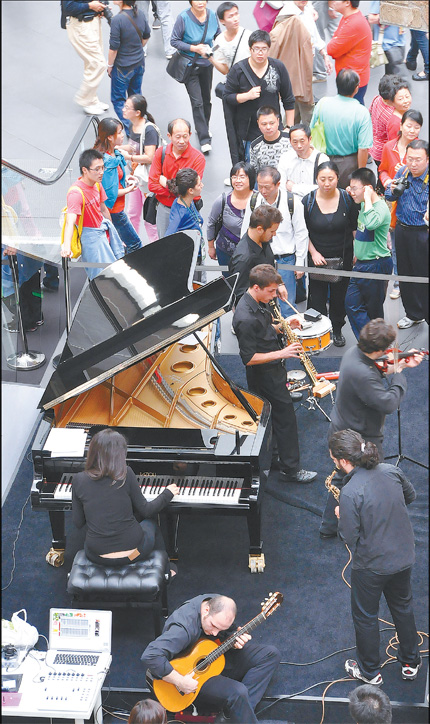Hearing 'music' in jarring notes of Shanghai noise
 |
| Visitors to the 2010 World Expo Shanghai are attracted by Metadiapason as they give a show at the Italy Pavilion. |
It's one of the first things someone new to Shanghai would notice: the sheer noise of everyday life, the constant banging, beeping and rumbling that give Shanghai its unique charm.
The Shanghainese probably wouldn't think of it as music to their ears, but a group of Italian musicians visiting for the Week of Rome celebrations at the World Expo say it is to them.
Metadiapason is a 12-piece group of experimental and improvisational performers who recently staged in the Italy Pavilion.
They explore the intersection between noise and sound and push the boundaries of what is considered "music."
The name "Metadiapason" means something like "with and through the sound" in ancient Greek.
The group records and then processes, modifies and elaborates the sounds of cities. They then perform live and improvise, combining the sounds with both traditional and non-traditional instruments.
Six members, including piano, saxophone, guitar, percussion, electronics, and strings players, traveled to Shanghai and performed as part of the Luce Architettura Musica (Light, Architecture, Music or LAM) project organized by the Italy's World Expo Commission and the Italian Chamber of Commerce in Shanghai.
In the daily bustle of Shanghai, Metadiapason project leader and musicologist Leonardo Zaccone says he hears a symphony, not cacophony.
"You can listen; there is a symphony of cars here in Shanghai," Zaccone says. "Every car, every motorbike - they are very noisy - but this noise is a musical form. I think you can create music with every sound."
Zaccone is a classically trained musician - he plays cello and violin and studied music history in Rome - but now specializes in contemporary and electronic music.
In the group's Shanghai performances he used an original instrument that he designed, built himself and christened the "Purplephone."
It works like a synthesiser and uses light to create sound. A light sensor makes a tone, which changes in response to the "player" shifting how light or dark it is.
Zaccone says they were inspired by, among others, Italian composer Luigi Russollo who experimented with noise and music at the turn of last century, and American John Cage who is best known for his 1952 composition 4'33" in which not a single note is played, audiences being encouraged to listen to the sound of the environment during the silence.
Metadiapason have experimented with objects as unlikely as washing machines to create music.
"The button sounds, the start sound, the water sound - a washing machine has more than 20 sounds normally - everything is a complex sound in itself and you have just to find out," Zaccone says.
Just like the sounds of everyday life, their music is not always clean-cut and predictable, or even nice-sounding.
"What we love more than a cosmetic sound is to perform these sounds live," he says. "The results are not always good, but it is not really important. What is important is that we are researching a new level of sound."
The wider Light, Architecture, Music project is an initiative to build a cultural bridge between Italy and China.
A Chinese-language LAM website will make it possible for Chinese to keep in touch with Italian musicians and architects, and to help them realize experimental projects around music, lighting and architecture in cities, Zaccone says.
"I think the project is nice because we have now in Italy many ideas, but very few ways to realize them," he says. "China is now a very, very innovative country and to realize this bridge could be a very good idea."
 0
0 







Go to Forum >>0 Comments